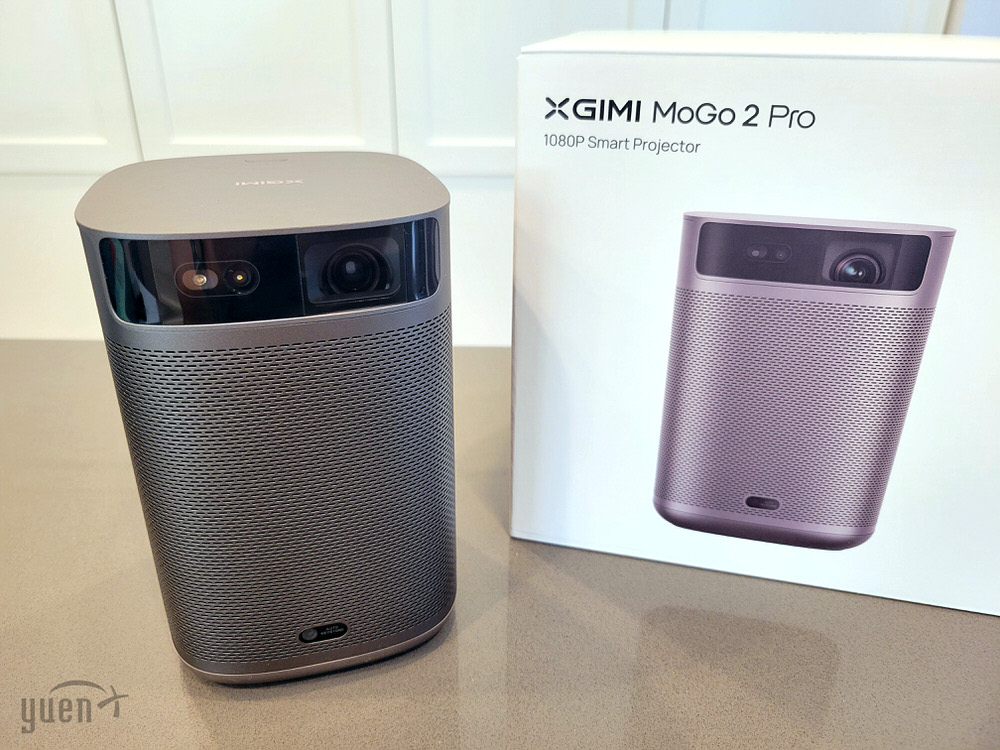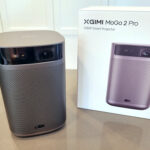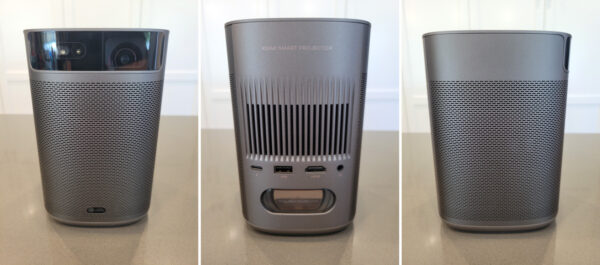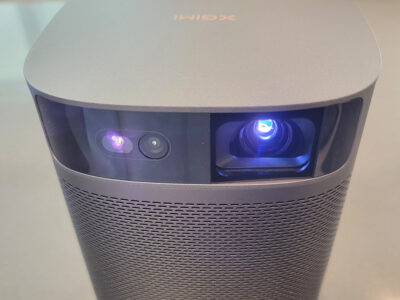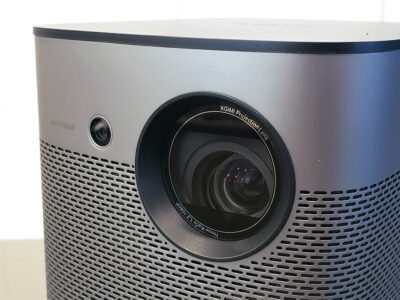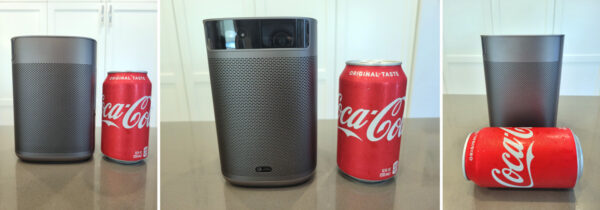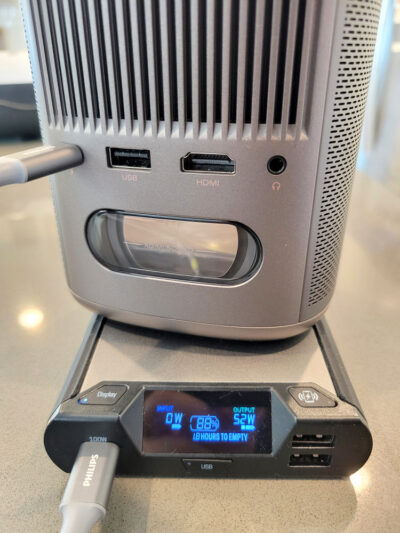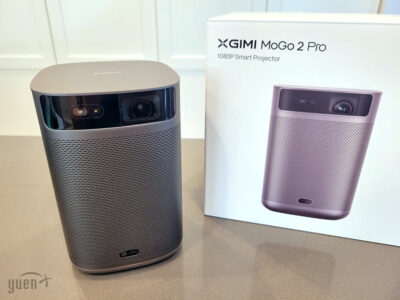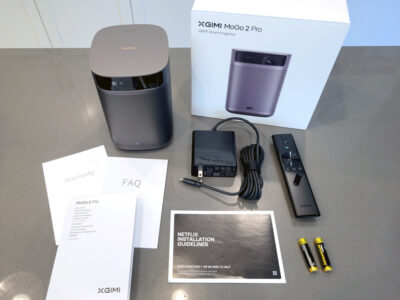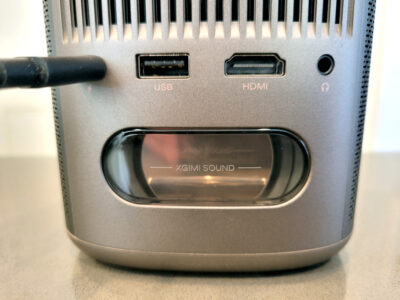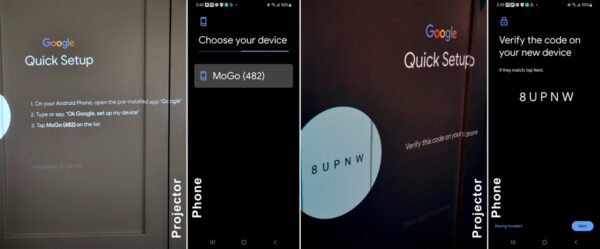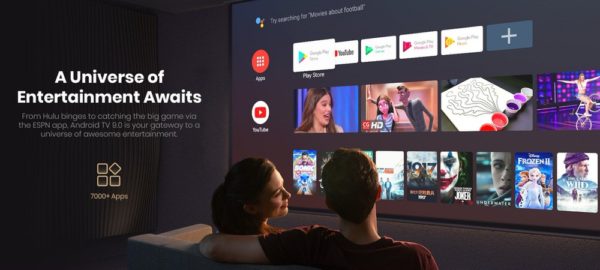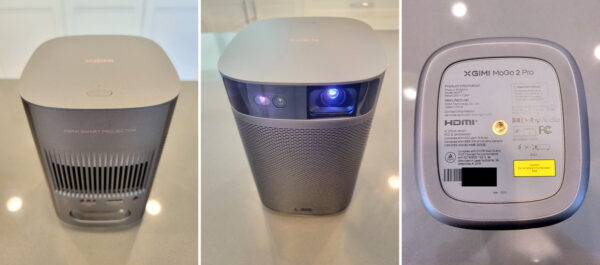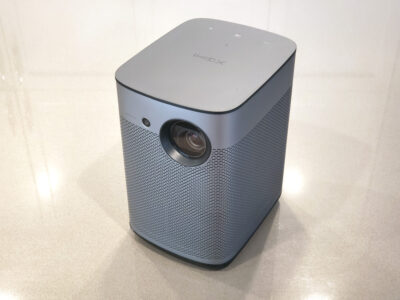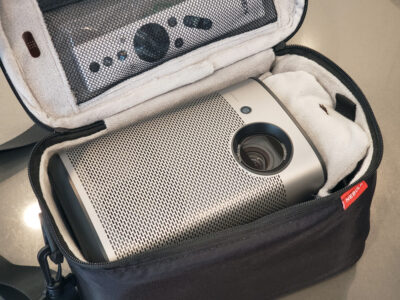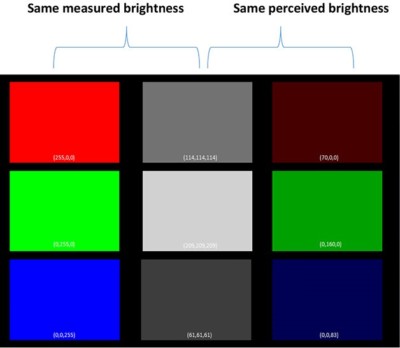Contents
Portable Travel Projector
There are many, many portable projectors to choose from with a wide variety of sizes, features, and price tags. Xgimi is one of the brands that immediately comes to mind after I had a positive experience with their battery-powered Halo (1080p) about 2.5 years ago in early 2021. I even wrote an extensive review about it, but never completed it for posting here at YuenX because it did not fully meet my publication standards at the time. (Sorry, readers!)
When the company released the MoGo 2 Pro, I was intrigued to see how it would compare with its updated smart TV feature and lower price. I reached out to Xgimi for a review unit and they happily obliged.
Disclosure: We received this product free in exchange for a review. We were asked to focus only on the manufacturer’s product line and to allow them to review the article for accuracy prior to publication. We test each product thoroughly, give high marks to only the very best, and the views expressed here are honest and our own. Learn more
In this review, we will go over the MoGo 2 Pro and how it compares to both the lower-end MoGo 2 and the battery-powered Halo 1080p.
Analysis
Xgimi had been a brand that garnered a few design awards with specifications that looked quite impressive. In fact, their battery-powered Halo (1080p) still ranks among some of the better projectors currently on the market with a long run time, bright and fairly color-accurate projection, great sound, and professional exterior.
The company’s MoGo 2 series aims to fill the lower-priced market with specifications that are identical to the Halo. In fact, the MoGo 2 Pro is so similar to the Halo 1080p, the average consumer may not notice the difference except that one is battery-powered and the other requires an external power source. Let’s take a closer look.
This review will go over some projection basics and what makes a projector better than another.
Hardware
Immediately noticeable when unboxing the MoGo 2 Pro’s packaging was a similar feel to that of the Halo 1080p. A clean, white box with minimal graphics on the outside, and the inside containing the projector, remote, two AAA batteries, documentation, and a large, USB-C wall adapter.
At first glance, the projector reminded me of Robocop with a visor housing the lens at the top of its face. MoGo 2 Pro felt noticeably lighter, slightly smaller, but less expensive than the Halo and for good reason: it does not contain a built-in battery. In fact, it requires a power source of at least 65W, though I tested it with a high-quality power bank drawing just 52W. The decoupling of the battery has advantages and disadvantages:
- Pros of no battery
- Less expensive
- Lighter
- External battery can be replaced once its lifetime has been depleted
- No risk of fire during transport and can be carried on an airplane
- Cons of no battery
- Requires an external power source, such as a battery or AC wall, to operate
- May not be suitable for some road warriors as a battery would also need to be brought
- Requires an external power source, such as a battery or AC wall, to operate
At 6.3″ x 4.7″ x 4.3″ and 2.4 lbs, the MoGo 2 Pro is about 30% taller than a 12oz (355mL) soda can (compared to Halo’s 6.8″ x 5.7″ x 4.5″ at 3.5 lbs). An official carry case is available. MoGo 2 packs 400 ISO Lumens of brightness compared to Halo’s more intense 800 ANSI Lumens (see “Projector Basics” section in this review to learn about both ratings). There is no direct ANSI-to-ISO conversion available because both are different standards, but some may “convert” 800 ANSI Lumens to roughly 1,000 ISO Lumens. Take that with a grain of salt.
MoGo 2 Pro’s lower-end model, the MoGo 2, offers just 720p HD resolution, whereas the Pro version and Halo both deliver native 1080p pixels for sharper, more readable text and crisper images at a projected size of up to 120″. Imagine that… a 120″ screen while out at the park. The projector supports up to 4K input.
ANSI or ISO Lumen Rating?
The ANSI Lumen standard was considered the most accurate, international measure of a projector’s light output. However, the ISO Lumen had been gaining ground because of its stricter measurement methods across a larger sample size under the ISO21118 specification. An exact conversion between both standards, as such, is not possible. Major companies, including Epson and Philips, had agreed to use ISO Lumen as the de facto standard, and the former started suing companies that did not. Many projectors we had come across indeed had grossly overstated their ratings with insignificant, non-standardized measures like lux, contrast ratio, and lumens, to unfairly confuse and attract consumers. Look for those that have ANSI or ISO Lumen numbers during your research.
MoGo 2 Pro’s 400 ISO Lumen brightness rating makes it best suited for small-to-medium sized rooms.
With a throw ratio of 1.2, a 16:9 aspect ratio image could be projected to the following diagonal sizes from the listed distances:
- 60″ @ 5.17′ (1.58m) / 70″ @ 6.08′ (1.85m) / 80″ @ 7′ (2.13m) / 90″ @ 7.8′ (2.38m)
- 100″ @ 8.75′ (2.67m) / 110″ @ 9.58′ (2.92m) / 120″ @ 10.65′ (3.25m)
HDR (HDR10) performance was excellent and on par with a competitor I had recently tested, but comes with 3D support that the other lacked.
Daytime performance in a shaded room was better than expected from a projector this small with movies being very watchable with good color accuracy, barely noticeable rainbow artifacts, and good contrast.
The front houses Autofocus and Auto Keystone Correction sensors and the projection lens, and the rear holds a USB-C, USB 2.0, HDMI (in), and Audio (out) port. The USB-C can ONLY be used for powering the projector (not the other way around) and cannot read data from it. A shiny, oval shape takes a large portion of the MoGo’s bottom space and is one of the more mesmerizing things to observe: the 2 x 8W Dolby Digital speakers vibrating the protective cover as deep bass flows through. On paper, it should be noticeably louder than Halo’s 2 x 5W, but upon closer listening, the Harman/Kardon partnership makes the Halo edge out with clarity at similar volumes.
The bottom has a threaded mount for attaching a tripod so the projector can be raised off the ground and positioned at a desired angle. It does not have a built-in kickstand.
The top continues one of the frustrations I had about its Halo cousin: lack of physical controls. It simply has just a power button. Some may like this simplicity, but I strongly dislike being forced to use a remote — losing it would render the MoGo (or Halo to some extent) an expensive doorstop. The probability of misplacing it during travel becomes exponentially higher when kids are involved.
One should note that the LED (light source) projection dims when a child, pet, or any object passes in front of the lens to protect those sensitive to bright light. However, at 400 ISO lumens, the brightness is not high enough to cause damage to the eye when briefly looked at. I was disappointed that the company continued to not include a built-in lens cover, and so I strongly suggest getting a nice travel case for protection against damage and smudges.
Automatic focus and keystone correction are some of the key features available in today’s higher-end projectors. A few seconds after moving the device, a black-and-white calibration graphic is displayed and then analyzed by a small lens at the top part of the front face and the Keystone sensor at the bottom. Seconds later, you usually end up with a sharp image. The process can also be initiated by pushing the appropriate button on the remote. The picture can be projected in front of or behind a screen whether standing up or hanging upside down thanks to a threaded 1/4″ hole on its bottom for mounting to a tripod or ceiling.
The projector houses an internal 16GB storage and can be augmented with a FAT32-formatted USB thumb drive via the USB-A port.
Power usage was at up to 65W though I saw it hover around 52W while projecting. That would give between 1.5 – 2 hours of runtime with a 100Wh power bank. The included AC wall adapter outputs up to 65W (20V @ 3.25A).
The projector can be controlled with the included remote (3 AAA batteries) or by pairing it s smart TV feature (Google Android TV) with the “Android TV” app on an Apple iOS or Android mobile device. It unfortunately only has one physical button: Power On/Off. I would have liked to find at minimum controls for volume changes, fast-forwards, rewinds, and play/pause without having to reach for a remote or mobile app. Google’s Chromecast is built-in to allow supported apps and devices to project content to the MoGo.
Smart Features
At the heart of the user interface is Google’s Android TV 11, a version even newer than the Halo’s Android TV 9. Keep in mind that even though the latest Android TV is version 13 (released December 2022), developers usually lag behind due to the extensive testing that should be done prior to production release of their own products. Android TV is a television-optimized operating system that provides access to 7,000+ apps through the Google Play Store and includes Google Assistant (voice control and queries) and Chromecast mirroring technology. The latter allows mobile devices to project their screen or audio to the Capsule 3. Alternatively, you can also install the “AirScreen” app to enable Apple devices to mirror their screens via AirPlay. I was pleased to find that Xgimi did not lock down its projector, and so I was able to sideload apps (via USB or WiFi) that were not available through its Google Play Store, including Total Commander (apk) file manager.
Setup was simple with Google guiding you through the process. Do note that a Google Account is required for the smart features to work. You may choose not to provide one, but usability will be severely hampered. Sign up for a throwaway dummy account with fake information if privacy is a concern for you. When you sign in with an existing Google Account, you will be prompted whether to copy any settings to the projector for simplified setup.
Some of my favorite apps to install are: Netflix (see note below), VLC Player, ABC News Live, Plex, Total Commander, File Explorer, or X-plore.
Xgimi plays a soothing song that comes default with Android TV while walking through the Google Android TV setup process. Some manufacturers choose to turn off the music.
Netflix Installation
Due to certification requirements set by Netflix, the app unfortunately cannot be directly downloaded from the Google Play Store. Instead, launch the Desktop Launcher app from the Google Play Store and follow the printed “Netflix Installation” instructions.
As previously stated, because this version of Netflix (for mobile devices) is not optimized for TVs, navigational controls require a mouse, but do yourself a favor and pair the projector with the “Android TV” app on your mobile device for touch controls. Netflix also cannot be added as a Favorite App to show at the top. I know, I know… I wish that Netflix and Xgimi/Android TV played well too, but this problem is not unique to just Xgimi. I have seen it with other manufacturers too.
Performance
Images were sharp, clear, and excellent to view with brightness sufficient for a sunlit room — especially when connected to a suitable (65W officially, but 52W was fine) power source and brightness set to full. Videos projected without any visible lag, and audio was crisp and clear with a good amount of bass. High-intensity gaming, unfortunately, was not possible due to input lag, but casual games like Minecraft and Grand Theft Auto: Vice City played wonderfully.
That leads us to one of my biggest, initial gripes with the MoGo 2 Pro: its Android TV 11 performance. Despite videos playing perfectly once launched, the menu/user interface was a bit sluggish, and controls were slightly delayed in their responses. Honestly, this issue is not unique to just the MoGo 2 Pro — it happens on another, much more expensive projector I had recently tested. Stutter is often observed upon initial configuration of an Android device (like smartphones) because of the number of concurrent processes that run during setup. It eventually subsides once optimizations are automatically applied. I encourage you to update your projector to the latest software as soon as possible for the latest performance optimizations and bug fixes. It was version 2.9.152 at the time of this writing.
Tip: Get the latest updates, bug fixes, and performance improvements by updating the projector’s firmware. Do so by going to Settings > Device Preferences > About > System Update. Be sure the power source is reliable. An upgrade should never be interrupted once started.
Specs Comparison
Here are the specifications of the Xgimi Horizon, Halo, and MoGo series projectors.
| Xgimi Horizon Pro | Xgimi Horizon | Xgimi Halo+ | Xgimi Halo | Xgimi MoGo 2 Pro | Xgimi MoGo 2 | |
|---|---|---|---|---|---|---|
| MSRP (Amazon) | $1,699 | $1,099 | $849 | $749 | $579 | $399 |
| YuenX Review | No | No | No | No | Review | No |
| Projection Technology | DLP | DLP | DLP | DLP | DLP | DLP |
| Light Source | LED | LED | LED | LED | LED | LED |
| Brightness (ANSI) | 2,200 ANSI Lumens | 2,200 ANSI Lumens | 900 ANSI Lumens | 800 ANSI Lumens | N/A | N/A |
| Brightness (ISO) | N/A | N/A | N/A | N/A | 400 ISO Lumens | 400 ISO Lumens |
| Resolution | 3840 x 2160 | 1920 x 1080 | 1920 x 1080 | 1920 x 1080 | 1920 x 1080 | 1280 x 720 |
| Projection Size | 60-150 in | 60-150 in | 60-120 in | 60-120 in | 60-120 in | 60-120 in |
| Operating System | Android TV 10.0 | Android TV 10.0 | Android TV 10.0 | Android TV 9.0 | Android TV 11.0 | Android TV 11.0 |
| Speaker | 2x 8W Harman Kardon | 2x 8W Harman Kardon | 2x 5W Harman Kardon | 2x 5W Harman Kardon | 2x 8W | 2x 8W |
| Video Playtime (Battery) | N/A (AC) | N/A (AC) | 2.5 hours | 2.5 hours | N/A (AC) | N/A (AC) |
| Battery | No | No | Yes. 59.5Wh | Yes. 59.5Wh | No | No |
| Power Consumption | < 200W | < 200W | < 90W | < 90W | < 65W | < 65W |
| Connectivity | HDMI (ARC), USB, Bluetooth, WiFi, Optical, LAN, Screen Mirroring, Chromecast | HDMI (ARC), USB, Bluetooth, WiFi, Optical, LAN, Screen Mirroring, Chromecast | HDMI (ARC), USB, Bluetooth, WiFi, Aux, Screen Mirroring, Chromecast | HDMI (ARC), USB, Bluetooth, WiFi, Aux, Screen Mirroring, Chromecast | HDMI, USB-C, USB-A, Bluetooth, WiFi, Aux, Screen Mirroring, Chromecast | HDMI, USB-C, USB-A, Bluetooth, WiFi, Aux, Screen Mirroring, Chromecast |
| Focus/Keystone | Automatic | Automatic | Automatic | Automatic | Automatic | Automatic |
| Memory (RAM) | 2GB | 2GB | 2GB | 2GB | 2GB | 2GB |
| Storage (Built-in) | 32GB | 32GB | 16GB | 16GB | 16GB | 16GB |
| Remote | Yes + App | Yes + App | Yes + App | Yes + App | Yes + App | Yes + App |
| Screen Fit | Auto | Auto | Auto | Manual | Auto | Auto |
| Weight | 6.39 lbs | 6.39 lbs | 3.5 lbs | 3.5 lbs | 2.42 lbs | 2.42 lbs |
| Size | 8.2" x 8.6" x 5.36" | 8.2" x 8.6" x 5.36" | 6.8" x 5.7" x 4.5" | 6.8" x 5.7" x 4.5" | 6.3" x 4.7" x 4.3" | 6.3" x 4.7" x 4.3" |
Final Thoughts
The Xgimi MoGo 2 Pro (1080p) produces sharp images with good brightness (400 ISO Lumens) in a small package just 1.3 times the height of a standard soda can. It is best suited for a small- to medium-sized room with enough capability to be used during the daytime. The projection quality could be enhanced with a 1.1 Gain (or higher) screen.
When asking the question on whether to get the MoGo 2 Pro or Halo, that would depend on the needs:
- For brighter images, a built-in battery, and slightly better sound, the Halo is a better choice
- For lower cost, lighter weight, slightly louder speakers, lower power consumption, a newer Android TV operating system, and the ability to take it onto a passenger flight, the MoGo 2 Pro would be the preferred choice
Personally, I prefer the Halo for road – and camping trips, but for light travel and taking onto flights, the MoGo 2 Pro is a good choice with its sharp 1080p resolution.
High-intensity gaming was still not possible with this projector due to lag, but we are hopeful to see the technology continuing to improve where one day, one could play Call of Duty on a huge 120″ screen without any loss of detail and responsiveness. Also encouraging were automatic adjustments of focus and keystone as I have continued seeing the industry improve in this area as a whole.
For a portable device, I was still disappointed with the lack of physical controls.
Where To Buy
- Projectors
- Xgimi
- AC-powered
- Portable: MoGo 2 Pro (1080p) / MoGo 2 (720p)
- Official Carry Case
- Home: Horizon Pro 4K / Horizon 1080p
- Portable: MoGo 2 Pro (1080p) / MoGo 2 (720p)
- Battery-powered
- AC-powered
- Xgimi
- Accessories
- USB-C PD Wall Chargers: Anker 65W / Goal Zero 65W
- Screen: 1.1-Gain Projector Screen
- USB Reader: elago Mobile Nano II microSD
- Tripod Stands
- Power Banks
- Devos Lightranger: Full campsite light coverage – See our Review
Related Reviews
- Anker Nebula
- Capsule 3 Laser vs vs Mars II Pro: Soda can-sized, 1080p laser projector with Android TV 11
- Mars II Pro vs Capsule (LED): Portable, battery-powered 720p projector with Android 7.1
- Cosmos Laser 4K vs Mars II Pro: Portable, 4K laser projector with Android TV 10 module
- Cosmos Max 4K vs Xgimi Horizon Pro (LED): 4K home projector with Android TV 9
Projector Basics
Brightness: Lumens, ANSI Lumens, ISO Lumens, and Lux
For a very long time, the lack of an apple-to-apple comparison between projector brightness had been a source of frustration. Measurements I had commonly seen were in lumens, ANSI lumens, and lux — and even then I found that two projectors with the same rating did not produce the same amount of brightness. You will find that there is no easy way to convert ANSI lumens to generic lumens.
Some manufacturers overstate their lumen rating in an attempt to sell more without regard to how the disinformation could hurt their brand — and customer trust — in the long run. Major companies, including Epson and Philips, had agreed to use ISO Lumen as the de facto standard, and the former started suing companies that did not. Look for those that have ANSI or ISO Lumen numbers during your research.
Terminology
- Lumens: Intensity of light (luminous flux) from a given source. This rating does not change regardless of distance from which the source is measured from
- Lux: Intensity of light at a specific location away from the source (1 lux = 1 lumen/sq meter). The farther away you travel, the lower the Lux rating, whereas Lumen remains unchanged
- ANSI Lumens: Was considered the most accurate, international measure of brightness emitted by a projector
- Rating was developed by the American National Standards Institute (ANSI). It is derived from measuring 9 points on a 3×3 grid as follows:
- Projector set 2.4m (7.9 ft) from the screen
- Projection size set to 60″ with a 3×3 grid
- Measure the illuminance of each of the 9 points on the grid
- ANSI Lumens = average of the 9 points multiplied by the total surface area of the projected image
- Older than ISO Lumen standard
- Rating was developed by the American National Standards Institute (ANSI). It is derived from measuring 9 points on a 3×3 grid as follows:
- ISO Lumens: Most accurate, internationally-recognized measure of a projector’s output performance
- Governed by ISO via the ISO21118 specification and is newer than ANSI Lumen
- Improves upon ANSI Lumen rating by taking multiple measurements across a larger sample size, among other stricter controls
- Major companies started moving away from ANSI towards ISO Lumen rating
Contrast Ratio
Projectors often include the Contrast Ratio in their list of technical specifications. It is a measurement of how dark and light the respective areas can be rendered, looking for the difference between the brightest and darkest pixels. For example, when watching a movie, you want the black to be as deep/dark as possible without affecting the lighter parts of the scene. This would result in a better experience with sharper, more detailed images and colors.
A higher contrast ratio is generally better and can go as high as 10,000:1 (white is 10,000x brighter than black), though the human eye will have difficulty discerning the miniscule difference past a certain point. A good ratio to look for should fall between 1,000:1 and 3,000:1. With all that said…
The contrast ratio practically is a meaningless specification. Ambient light and other factors can SIGNIFICANTLY affect the contrast, and as such, one should focus more on darkening the room and using a good projection screen. An optimally low-light room would yield no visible difference between 300:1 and a 50,000:1 contrast ratio.
Lumen-to-ANSI Lumen Conversion
Some sources use a 7x factor to convert lumen to ANSI lumen. Although this is NOT ACCURATE because of the many factors involved that affect brightness, it provides a generic reference to which to compare products by. Remember, ANSI lumen takes into consideration the projection distance, screen size, and 9 measurement points, whereas lumen only measures a light source’s fixed intensity regardless of the aforementioned elements.
In the case of the Xgimi Halo, its 800 ANSI lumen rating can be roughly converted to 5,600 lumens (800 x 7), and the Xgimi Horizon Pro’s 2,200 ANSI lumen to about 15,400 lumens (2,200 x 7).
ANSI Lumen-to-ISO Lumen Conversion
Like with Lumen and ANSI Lumen, conversion between ANSI and ISO Lumen is not possible due to differences between both standards. In general, ANSI tends to be slightly lower than ISO, and so for the sake of discussion, some sources use the following formula: ANSI = ISO * 0.8 (or) ISO = ANSI / 0.8. For example, a 2,400 ISO Lumen projector may very roughly be equivalent to 1,920 ANSI Lumen. A 2,000 ANSI Lumen may very loosely be converted to 2,500 ISO Lumen. Take the math with a heavy grain of salt, but looking at either ANSI or ISO Lumen is a great indicator to consider in your research.
ANSI/ISO Lumen-to-Room Size Recommendations
Common ANSI lumen ratings recommended for various room sizes are shown below. Keep in mind, however, that image brightness can be affected by ambient light, projection distance, screen size and type, light output technology and age, and other factors.
- Small room: 200-300 ANSI / 250-375 ISO
- Large room: 400-600 ANSI / 500-750 ISO
- Large auditorium: 2,000+ ANSI / 2,500+ ISO
Perceived vs Measured Brightness
According to Viewsonic, two projectors with the same ANSI lumen rating may appear different in brightness due to the human eye being “more sensitive to certain wavelengths of light”. In other words, more color-saturated images appear to be brighter as the result of the HK (Helmholtz-Kohlrausch) Effect. In the simulated illustration below, columns 1 and 2 have the same ANSI lumen rating, but the left appears to be brighter. Likewise, columns 2 and 3 appear to be equally bright but have different ANSI lumen measurements.
Furthermore, Viewsonic also points out that LED-based projectors produce higher, perceived brightness over older lamp ones despite having the same ANSI lumen rating.
Did you know? A projection screen with a gain rating of 1.0 preserves the image’s brightness, whereas a higher or lower number will respectively increase or decrease it. For instance, the Gain rating of 1.1 with the 100BTF Screen with Stand (120″ / 135″) ensures the image brightness is not hampered by that product’s material.
Metal-Halide, LED, Laser, DLP, and LCD
Projection Systems
- DLP: Texas Instruments’ Digital Light Processing (DLP) technology provided a significant leap in projection through the use of expensive, spinning color wheels that produced sharp images, was 3D capable, and had low response times suitable for video playback
- LCD: LCD projectors work great for movies, have no moving parts, are generally less expensive than DLP, but output less contrast and require filter maintenance
There is almost no visible difference in quality between DLP and LCD today.
Light Sources
- Metal-Halide Lamp: One of the oldest, but still most commonly-used lamps produces bright images with excellent color rendering
- Get very hot and only last 2,000 – 5,000 hours before needing replacement at an exorbitant cost
- A noisy fan must be left running for a while after power off to ensure adequate cooling before putting the unit away
- Avoid touching the lamp with your naked fingers because the skin oils can degrade the coating and cause the bulb to explode when turned on
- LED: With a lifespan of over 20,000 hours, LED projectors generate very little heat and power consumption and require almost no maintenance. Their brightness and image sharpness trail Metal-Halide lamps, though the gap has slowly been closing
- Laser: Next-generation light source with generally superior brightness, greater energy efficiency, color accuracy (wider range of adjustable colors than LEDs), lifespan, image quality, and virtually zero maintenance
- Can be mounted at unusual angles, such as those by Ultra Short Throws (UST)

